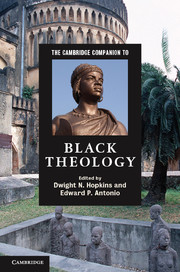Book contents
- Frontmatter
- Part I Introduction
- Part II Themes in black theology
- 6 God
- 7 Jesus in black theology: the ancient ancestor visits
- 8 Black theology and the Holy Spirit
- 9 Black theology and human purpose
- 10 Theology's great sin: silence in the face of white supremacy
- 11 Theodicy: “De Lawd knowed how it was.” Black theology and black suffering
- 12 Black theology and the Bible
- 13 Protestant ecclesiology
- 14 Roman Catholic ecclesiology
- 15 Dignity and destiny: black reflections on eschatology
- Part III Global expressions of black theology
- Further reading
- Index
- Other titles in the series
7 - Jesus in black theology: the ancient ancestor visits
from Part II - Themes in black theology
Published online by Cambridge University Press: 28 September 2012
- Frontmatter
- Part I Introduction
- Part II Themes in black theology
- 6 God
- 7 Jesus in black theology: the ancient ancestor visits
- 8 Black theology and the Holy Spirit
- 9 Black theology and human purpose
- 10 Theology's great sin: silence in the face of white supremacy
- 11 Theodicy: “De Lawd knowed how it was.” Black theology and black suffering
- 12 Black theology and the Bible
- 13 Protestant ecclesiology
- 14 Roman Catholic ecclesiology
- 15 Dignity and destiny: black reflections on eschatology
- Part III Global expressions of black theology
- Further reading
- Index
- Other titles in the series
Summary
INTRODUCTION
For too long, Judeo-Christianity has been viewed as a Western Christian tradition mediated by the entrepreneurial agents of colonial missionaries from Europe for the “enlightenment” of the vast majority of the world's people, most of whom are overwhelmingly of color. Since Christianity as we know it in most places in the world today, with the exception of places such as Egypt, Ethiopia, Iraq, Jordan, Palestine, India, and other places in close proximity to the confluence of the African-Asian world, has generally been a Western European transmission with its concomitants of colonization and slavery, much of the world has ineluctably been indoctrinated with the hegemonic ideological imposition that Jesus of Nazareth was a “white man” so depicted in the plethora of books, paintings, pictures, and stained-glass windows around the world.
This chapter takes issue with this lethal Eurocentric definition and depiction of Jesus of Nazareth in Palestine. Because Christianity has essentially functioned as an ideological ploy by Western colonialism to proclaim the superlative distinction of Christendom in contrast to other traditions as part and parcel of the fabrication of the supremacy of European cultures in comparison to other world cultures, Western Christianity has always speciously claimed that it was derived from a tradition of unadulterated essentialist Judaic tradition that signified divine intervention in the lives of Judeo-Christians unparalleled in any other people's history.
- Type
- Chapter
- Information
- The Cambridge Companion to Black Theology , pp. 94 - 110Publisher: Cambridge University PressPrint publication year: 2012
- 1
- Cited by



